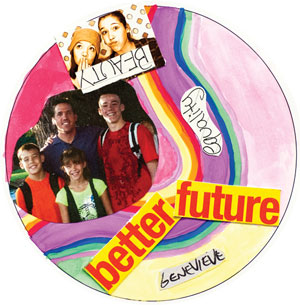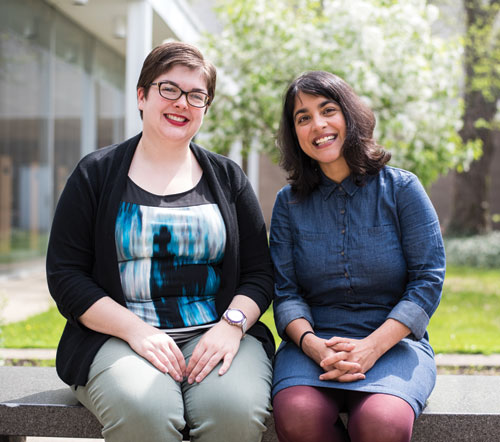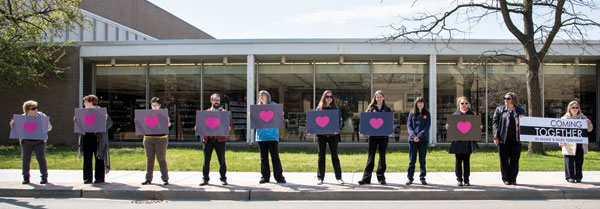Skokie Library Tackles Race

Illinois Secretary of State Jesse White greets a young audience member
during a Voices of Race event at the Skokie Public Library, IL.
All photographs by Max Herman.
On a sunny Friday morning in April, more than 40 staff members of the Skokie (IL) Public Library (SPL), from pages to the director, stepped onto the sidewalk along Oakton Street, a main road in this village of 65,000. Joined by dozens of library patrons of all ages, we lined up, holding signs depicting hearts on backgrounds fading from black to white. Cars honked, and flags flew from municipal buildings. We were participating in Stand Against Racism, a multi-day, national initiative from the YWCA.
Our action also culminated a four-month program in our own community called Voices of Race. It was part of an annual event, Coming Together in Skokie and Niles Township (CTIS), launched in 2010 by five community agencies and leaders, including our library. The mission was to celebrate and uplift the voices of this diverse community, where nearly 100 languages are spoken and more than 40 percent of the population is foreign born. The largest immigrant groups in recent years are from Iraq and Pakistan. Past celebrations have recognized the cultures and literature of our Asian Indian, Filipino, Assyrian, Greek, and Korean communities. The CTIS planning group decided that this year, the program would specifically explore race.

A student collage displayed
in an exhibit at the library.
Why? The truth is recognizing and celebrating diversity does nothing to address the systemic, daily racism that affects our communities and many of our library patrons. This decision was made in the spring of 2014, well before the August shooting death of Michael Brown in Ferguson, MO, reignited national conversations about race and inequality. The leadership homed in on race for two reasons: to extend conversations around an exhibit, “Race: Are We So Different?” at the Illinois Holocaust Museum in Skokie, and to shift the conversation from celebrating diversity to talking about local experiences of race.
Skokie mayor George Van Dusen specified his desire that community groups would “gain understanding of one another, and through that understanding, develop compassion for one another and build a stronger community.” Recognizing that this aspiration could come off as superficial despite best intentions (consider the ill-fated Starbucks #RaceTogether campaign), the CTIS planning committee—now a group of more than two dozen diverse representatives from cultural and ethnic associations, schools, and community institutions—internally discussed how best to publicly talk about race and privilege. Peggy McIntosh’s seminal 1988 essay “White Privilege: Unpacking the Invisible Knapsack” was vital to these early discussions. Over the four months, institutions would host events, open to the public and promoted through the SPL website (ComingTogether.in) and a distributed booklet.
Our library team, comprised of Mimosa Shah, adult program specialist; Jessi Schulte Honstad, young adult services supervisor; Christie Robinson, communications and marketing manager; and ourselves (Amy Koester, youth and family program coordinator, and Amita Lonial, learning experiences manager), also believes that while events about diversity may be more comfortable, truly meaningful conversations and deep self-reflection are what affect change.

Amy Koester (left) and Amita Lonial.
The conversation
Talking about race can be fraught with tension; individuals may feel guilt, shame, or anger when confronted with a person’s experience that conflicts with their own worldview. At one library event, a conversation about a woman’s experiences of others touching her hair without permission was met with a defensive retort: “Why are we even focusing on race when slavery ended 150 years ago?” We could have redirected the conversation. Instead, by probing why lived experiences elicit strong emotions, we can start to dismantle beliefs that systematically and negatively affect people. Radical change can begin.
We created two cornerstone initiatives. First, our annual Winter Reading Program centered on Voices of Race. Second, we asked patrons to participate in activities that included reading the featured texts, attending events, and participating in an exhibit in which they expressed their thoughts on flags displayed in the library lobby.
“We knew that race could be a tough topic for people to talk about,” says Lynnanne Pearson, SPL manager of adult popular services. “We wanted to give people many ways to approach it, and to give families, especially, tools to talk about this topic in an accessible way.” Library cardholders and others registered as individuals or as a family. Participants received a knapsack (inspired by McIntosh’s essay) including recommended books and films, conversation starters, an explanation of the exhibit, a booklet listing community events, and the blank flags on which patrons of all ages could express, through visuals and/or words, what race and racial identity mean to them.
More than 100 of these flags were exhibited in the lobby alongside quotes from Sonia Sotomayor, Nelson Mandela, bell hooks, and Ani DiFranco. The flags voiced all manner of thoughts, personal and political. “I see myself in black and white. I want others to see me the same way,” read one. “I want them to see me by my actions, by my personality, by my character.” Another said, “I am distinct, not a stereotype. But when you look at me you see me through your own lens.” Others depicted colorful collages, drawings, and personal ephemera. (Watch a time-lapse video of the exhibit.)

Library staff and others take part in Stand Against Racism outside SPL.
Slam poetry, intergenerational stories
Preschoolers through teens participated in developmentally appropriate ways. A teacher-artist from Chicago Slam Works, an organization dedicated to poetry performance, education, and community-building, offered workshops introducing kids to slam poetry and its power to tell stories. Participants composed and shared their own poetry about their experiences with race or difference. Fourth graders through high schoolers said that they felt “empowered” by the two-hour workshops, that their poetry helped them feel “pride and purpose,” and that they better understood why “race matters.”
Suggested Reads
 For Children
For Children
Linda Sue Park Xander’s Panda Party (Clarion, 2013)
Barack Obama's Of Thee I Sing (Knopf, 2010)
For Teens
Joan Steinau Lester's Black, White, Other: In Search of Nina Armstrong (Zondervan, 2012)
For Adults
Gail Bush's Indivisible: Poems for Social Justice (Norwood House, 2013)
Edward Kelsey Moore's The Supremes at Earl’s All-You-Can-Eat (Knopf, 2013)
During another event, “A Day in My Life,” children attended with a caregiver, and each pair received a book template with questions: for example, What is/was it like to grow up in a certain place, to go to school, and to dream about the future at a certain age? The partners filled their books with words and pictures capturing their conversations. One granddaughter and a grandmother discussed how, when the elder was a child, girls had fewer options for future careers. Another child expressed shock at his grandfather’s account of not being able to swim in a community pool when he was a child because it did not allow Jews.
During a packed “Courageous Conversation” event with Illinois Secretary of State Jesse White and Mayor Van Dusen, White recounted working alongside Martin Luther King Jr. during the 1960s, as well as the many incidents of racism he experienced as a minor league baseball player in the 1950s. “[I] left [the event] feeling inspired to tell my own story as a way toward peace and healing,” one participant said.
“Off the Record: Race Representations in the Media” was a panel that included a journalist, media scholar, and documentary producer discussing how news media affects understanding of race relations. Panelists addressed the underreporting of news stories involving minorities and the preconceptions readers may have about communities of color. “Journalists are tied to reporting the facts,” said Shah, “but readers interpret those facts through a lens of their own biases.”
SPL also hosted authors of recommended books: Joan Steinau Lester, author of Black, White, Other: In Search of Nina Armstrong (Zondervan, 2012) and Edward Kelsey Moore, who wrote The Supremes at Earl’s All-You-Can-Eat (Knopf, 2013).
Lessons learned; challenging dialogues
What did our programming team learn? First, it is essential to offer a variety of ways for people to engage. Race is a private and a public topic, and creating opportunities to reflect at home—as well as participate in public lectures, dialogues, and exhibits—acknowledges that duality.
A second lesson concerns proper training for supporting honest discussion. It is imperative to work with community leaders of color, and for all participating agencies to have difficult, explicit conversations about race and privilege early, in order to approach the topics in ways that are mindful, respectful, and responsible. “The dialogue around race can become challenging…[I hope we will] work through tough impasses and move toward building a community that is known for its determination to hear all the voices that have been silenced or ignored in the past,” one Skokie resident commented.
Finally, we learned that a four-month program is insufficient. It is a first step toward a larger, longitudinal commitment to equity and social justice. Libraries must shift our conversation from increasing diversity to talking about racial equity and adopting an antiracist framework. It is up to us to go further, even if it makes us uncomfortable, and to do more for and in our communities.
Talking Points
Six prompts to start meaningful conversations
In what ways were you aware of your racial/ethnic background when you were growing up? How would you describe your background?
How has race affected your life? Can you think of specific, tangible examples?
Name three feelings that come up when you hear the word racism.
When and how have you challenged racism?
When and how have you failed to challenge racism?
What can we do as a community to stand up against racism?
Ground rules for keeping the dialogue responsible and safeNo single speaker should dominate the conversation. All participants should have the opportunity to participate.
Refrain from making generalizations about groups of people, for example: “All Latinos….” Instead, share personal perspectives and experiences.
Listen to the perspectives and experiences of others, and recognize that they are valid, regardless of whether you agree. All people have a right to their own truth.
If you become uncomfortable, ask yourself: What about a particular statement or idea causes you discomfort? Challenge yourself to see the idea from a perspective other than your own.
RELATED
The job outlook in 2030: Librarians will be in demand
The job outlook in 2030: Librarians will be in demand
ALREADY A SUBSCRIBER? LOG IN
We are currently offering this content for free. Sign up now to activate your personal profile, where you can save articles for future viewing





Add Comment :-
Comment Policy:
Comment should not be empty !!!
Charles Waters
What a vital, courageous, all-encompassing topic in which to tackle. I admire the research, dedication, step by step ways we can look within ourselves to be mindful of living a better life for ourselves, our communities, and the next generation who will look to us for guidance. Bravo!Posted : Jul 24, 2015 01:16
Stephanie
I'm working with a few students this summer and our main text is Joan Steinau Lester's Black, White, Other: In Search of Nina Armstrong. This book is definitely a go to when discussing race with teens.Posted : Jun 19, 2015 11:24